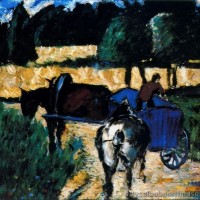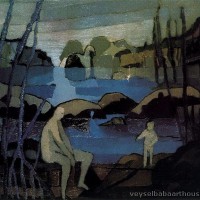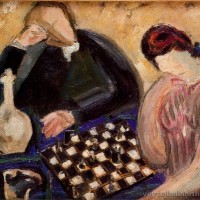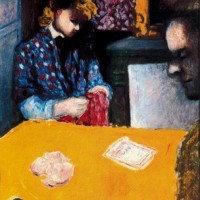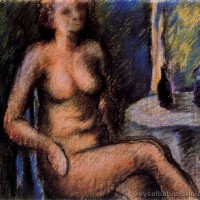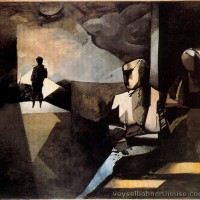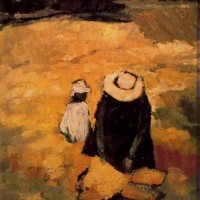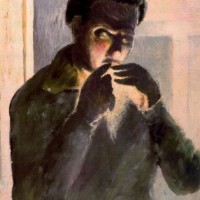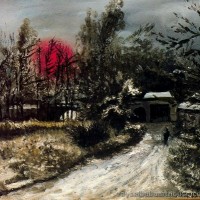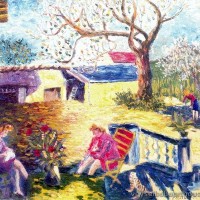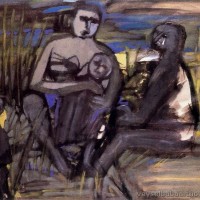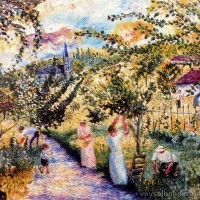- Home
- ABOUT US
- ABOUT VEYSEL BABA
- REDFOX ART HOUSE VIRTUAL TOUR
- MY LAST WILL TESTAMENT
- NOTES ON HUMANITY AND LIFE
- HUMAN BEING IS LIKE A PUZZLE WITH CONTRADICTIONS
- I HAVE A WISH ON BEHALF OF THE HUMANITY
- WE ARE VERY EXHAUSTED AS THE DOOMSDAY IS CLOSER
- NO ROAD IS LONG WITH GOOD COMPANY
- THE ROAD TO A FRIENDS HOUSE IS NEVER LONG
- MY DREAMS 1
- MY DREAMS 2
- GOLDEN WORDS ABOUT POLITICS
- GOLDEN WORDS ABOUT LOVE
- GOLDEN WORDS ABOUT LIFE
- GOLDEN WORDS ABOUT DEATH
- VEYSEL BABA ART WORKS
- SHOREDITCH PARK STORIES
- EXAMPLE LIVES
- ART GALLERY
- BOOK GALLERY
- MUSIC GALLERY
- MOVIE GALLERY
- Featured Article
- Home
- ART GALLERY
- Paul Ackerman
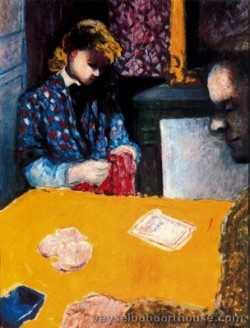
Paul Ackerman
Paul Ackerman , 17 September born 1908 in Iaşi ( Romania ) and died in Paris the 13 March 1981 , is a painter , lithographer , sculptor and stage designer Romanian.
Living in France since 1912, it belongs to the School of Paris .
Biography
Paul Ackerman was four years old when, in 1912, his father, company director and great art lover, decided by constraint facing "anti-Semitism is a harsh reality in Romania" 1 , of settling in Paris 2 , in a large villa facing the Bois de Vincennes . He attended high school at Lycée Charlemagne (where he formed a lasting friendship with Gabriel Arout , future playwright who later he produced the sets), then the Alsatian School . In 1925, Ackerman studied law and literature at the Sorbonne 3 , but regularly attending the Louvre , he knows that his vocation is elsewhere.
In 1933, Paul Ackerman met Simone Laverrière, from Royan , whom he married in 1935. In 1936, in his studio 100, Rue du Faubourg Saint-Honoré , he designs posters projects, tissues and jewelry for Elsa Schiaparelli and Marcel Rochas while attending workshop Fernand Léger .
1939 World War II : Paul Ackerman is mobilized, then imprisoned, released, found his wife Simone in Vichy where expelled as a Jew, he moved to Saint-Tropez . He leads in the south of France a cloistered life, made of small ways (painting on newspaper), but also of a great friendship, that of Pierre Bonnard 4 . From 1942 to 1945, he continues this cloistered life in Chindrieux , there painting landscapes of Savoy , nudes, still lifes and self-portraits .
With the release , Paul Ackerman found from 1945 his Paris studio, however, making returns to Saint-Tropez, finding Pierre Bonnard and attending Pablo Picasso . In Paris, his great meetings are then Jean-Michel Atlan , Jean Dubuffet , Serge Poliakoff and especially Alexander Garbell he befriends. There followed quickly the first exhibition at Raymond Creuze in 1947, the Prix Pacquement in 1950.
The work of Paul Ackerman is characterized by its versatility, variations, mutations, stages, periods, cycles, turns, metamorphoses and even contradictions. Having never been a prisoner of style, he is at the same time one of the most secret painters of his time and one of those who bear witness to it. If in the 1950s the formal aspect of his work in the ranks of abstract painting , a more pointed look is quick to identify the inspiring reality.
After a 180 ° Ackerman resolutely returns to figuration in his great cycles Rembrandt , Vivaldi , Dickens . Early on we guess filigree of his work reading some esoteric writers ( Rene Guenon in particular), as confirmed by his handwritten notes of personal reflections 5 but that contradicts the assertion of the artist: "I was guided by nothing, I do not know where these pictures have arisen and why I made them " 6 .
The propensity of Paul Ackerman in esotericism was confirmed in 1965 with the Agartha , defined by Rene Guenon 7 as "an underworld extending its ramifications everywhere under the continents" . Ackerman feels urged to make visible this invisible world. His work, and that's what makes its unity in its plurality, is therefore a metaphysical where everything takes on a meaning symbolic or cosmological .
"Or the time will be lenient with my work," writes Paul Ackerman in his notes, "and will give him that indispensable value that sensitises a work for generations to come, and in that case I will have been a living man, or time will erase what I did, and in this case I would never have been a little dust 8 " . Died in 1981, buried in the cemetery of Bagneux ( 4 th division) 9 .
Themes in the work of Ackerman
- Shadows and Enlightenment , 1926-1964.
- Paintings on newsprint, 1942.
- Cubist lesson from Paul Cézanne to Jacques Villon , 1946.
- The Reeds , 1949-1953.
- The Suns , 1950.
- Calligraphy 1952.
- Biblical themes and series Chinese 1953.
- Tabula Rasa 1956.
- Paints embossed on polyester, 1957.
- Obscure clear , 1960-1963.
- Rembrandt 1964.
- The Agartha , 1966-1970.
- Travel Bruegel , 1967.
- Vivaldi , Dickens 1970.
- Portraits in a mirror , 1975-1977.
- Beyond the actual 1979.
Exhibitions
Solo exhibitions
- Raymond Creuze Gallery, Paris, 1947, 1954 and 1957.
- Galerie du Siècle, Paris, 1950 (catalog prefaced by Loys Masson ).
- Royal Gallery, Paris, 1955.
- Galleria del Grattacielo, Milan , 1956.
- Galerie Motte, Paris, 1962.
- Approaches Rembrandt , Galerie Max Kaganovich , Paris, 1964.
- Homage to Rembrandt , Galerie Max Kaganovich, Paris, 1966.
- Leicester Gallery, London, 1967.
- Frankfurter Cabinet, Frankfurt am Main , 1968.
- Museum of Cassel (Hesse), 1968.
- Dresdener gallery, Montreal and Quebec , in 1968.
- Retrospective Paul Ackerman , Musée Galliera , Paris, 1970.
- Approach to Agartha , Kriegel Gallery, Paris, 1970 (with sculptures by Irene Zack ).
- Portraits in a mirror , Uppsala ( Sweden ) 1975.
- The journey of Bruegel , Abbey Commelles (0ise), 1977.
- Eurpean Art Gallery, Bucharest, June-July 2014 10 .
Group Exhibitions
- The inner world , Marseille , 1953.
- The garden , Luxembourg Palace , Paris, 1954.
- The thirty years of the gallery , Galerie Max Kaganovich, Paris, 1966.
- Drawings , Kriegel Gallery, Paris, 1967.
- Sixteen abstract painters , Galerie Max Kaganovich, Paris, 1968. Exhibition organized by the art historian Jean-Jacques Leveque (1931-2011) and bringing Paul Ackerman, Jean Messagier , Zoran Mušič , Olivier Debré , Paul Rebeyrolle , Key Sato , Zao Wou-Ki , Léon Zack , Árpád Szenes ....
- From private collections in France , Royal Academy of Arts, Burlington House , London, 1969.
- Tribute to Max Kaganovich , Kaganovich Gallery Madeleine, Paris, 1979. Exhibition bringing Paul Ackerman, Bill Parker , Anita de Caro , Jacques Boussard, Michel Cadoret and Isaac Pailes. Catalogue preface by Gaston Palewski .
- Expo Group: paintings, sculptures, drawings, collages - Works 1950-1970 years , La Capitale Galerie, Paris, December 2013 - January 2014.
Sets for theater
- The Queen of Clubs Gabriel Arout, Théâtre Saint-Georges , with Madeleine Robinson , in 1952.
- A woman too honest to Armand Salacrou , Théâtre Edouard VII (Paris), mise-en-scene of Georges Vitaly , with Sophie Desmarets , Jacques Jouanneau and Marthe Mercadier 1957.
- Potato of Marcel Achard , Théâtre Saint-Georges (Paris), mise-en-scene of Pierre Dux , with Pierre Dux, Maurice Teynac and Sophie Daumier 1957.
- The year 2200 , Théâtre Saint-Georges (Paris), 1964.
Illustrated books
- Jean-François Chabrun : Descriptions , poems accompanied by thirty lithographs by Paul Ackerman, Publishing Out Measure, Paris, 1968.
Critical reception
- "The work of this naturalized Romanian Romanian reflects in his evolution most of the pictorial movements that have followed each other since the 1930s. Yet a sort of paradoxical unity and the same spirit predominate during these different phases of creation: works of Ackerman keep narrowly decorative sometimes a poetic sense esoteric . " - Gerald Schurr 11
Awards and honors
- Charles Pacquement Award, 1950.
Museums
- Musée d'Art Moderne de la Ville de Paris .
- National Library , Paris.
- Musée des Beaux-Arts de Bordeaux .
- Ringling Museum of Art, Sarasota , Florida .
- Museum of Cassel (Hesse) , Germany .
Churches
- Chapel Boncourt (Eure-et-Loir) : paint on canvas frame and representing the Passion of Christ . It is a work of scale in black gray and bench whose successive scenes succeed one another by surrounding the whole of the apse of the church.
Radio emissions
- Fluoroscopy (Paul Ackerman) by Jacques Chancel , France Inter 1970.
